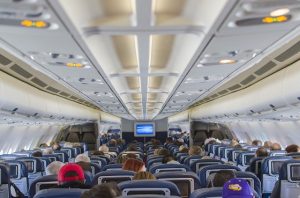 Have you ever stepped aboard a commercial airplane, only to discover the cabin is uncomfortably cold? While cabin temperatures vary, it’s not uncommon for commercial airplanes to maintain a chilly environment of 66 degrees to 68 degrees Fahrenheit. As a result, you might be wondering why airplanes are so cold? After all, most passengers will agree that even 68 degrees Fahrenheit is simply too cold.
Have you ever stepped aboard a commercial airplane, only to discover the cabin is uncomfortably cold? While cabin temperatures vary, it’s not uncommon for commercial airplanes to maintain a chilly environment of 66 degrees to 68 degrees Fahrenheit. As a result, you might be wondering why airplanes are so cold? After all, most passengers will agree that even 68 degrees Fahrenheit is simply too cold.
Low Humidity Makes It Feel Colder
The low humidity in commercial airplanes makes the cabin air feel colder than what it actually is. According to the World Health Organization (WHO), commercial airplanes have an average relative humidity of just 20%, meaning the cabin air is just one-fifth saturated with moisture. In comparison, the relative humidity level in a typical home may range from 40% to 60%.
Because commercial airplanes have low humidity levels, the air feels cooler than what it actually is. Humidity is a measurement of moisture airborne moisture. When the air is humid, the high level of airborne moisture vapor will insulate your body to minimize loss of body heat. When the air isn’t humid, on the other hand, the lack of airborne moisture vapor will result in your body losing heat more quickly. As a result, you’ll feel colder, even if the temperature doesn’t reflect it.
Cool Air Reduces Risk of Hypoxia
Using a lower temperature for cabin air also reduces the risk of hypoxia in passengers and crew members. A few years, ASTM International released a study showing a connection between instances of onboard fainting and cabin temperature. Researchers from ASTM International found that the combination of low oxygen levels and warm air increased the risk of fainting. When passengers were exposed to warm cabin air, they were more likely to experience hypoxia, resulting in fainting episodes.
Because heat increases the risk of hypoxia, commercial airlines tend to maintain a cool cabin environment. Airplanes naturally have less oxygen in the air than that of the ground air. Unfortunately, some people are susceptible to hypoxia when exposed to environments with low oxygen levels. To protect against hypoxia-related fainting, commercial airlines maintain cool cabins.
In Conclusion
Airplanes are cold for two reasons. First, the air inside a commercial airplane feels cold because it’s dry. With a relative humidity level of just 20%, airplane cabins feel colder than what they actually are. With that said, commercial airlines intentionally maintain cold air inside their cabins to protect passengers and crew members from hypoxia.



